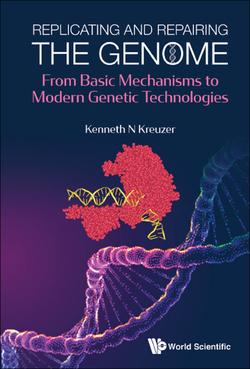Читать книгу Replicating And Repairing The Genome: From Basic Mechanisms To Modern Genetic Technologies - Kenneth N Kreuzer - Страница 23
На сайте Литреса книга снята с продажи.
2.7T7 ssDNA-binding protein helps to organize the replisome
ОглавлениеThe transient but fairly extensive regions of ssDNA on the lagging-strand template are blanketed by the ssDNA-binding protein, which both protects and organizes the DNA. The dynamics of protein binding to these single-stranded regions is fascinating. As mentioned above, ssDNA-binding protein has an acidic C-terminal extension. Indeed, 15 out of 26 residues in this extension are aspartic or glutamic acid. When free in solution, the ssDNA-binding protein forms a dimer in which the acidic C-terminal extension of each monomer binds to the (basic) DNA-binding site within the body of the opposite subunit (Figure 2.7). Binding of the C-terminal extension to the DNA-binding site presumably shields the protein from binding other negatively charged molecules in the cell and modulates the affinity of the protein for ssDNA.
Figure 2.7.Protein–protein interactions centered on the T7 ssDNA-binding protein. The acidic C-terminal tail of the protein is critical for interactions with itself and other proteins. In solution, the protein dimerizes via mutual interactions between the tail of one protein and the body of its partner. Once bound to ssDNA, the acidic C-terminal tail becomes available for interactions with the DNA polymerase and with the helicase/primase, as shown at the bottom of the figure.
The C-terminal extension of the ssDNA-binding protein is the region that binds the T7 DNA polymerase and helicase/primase. This implies that the dimer in solution has weakened interactions with these replication proteins. However, upon binding to ssDNA, the C-terminal extensions are displaced from the DNA binding sites and thereby become available for interactions with the other replication proteins (Figure 2.7). Overall, this simple but elegant architecture of the ssDNA-binding protein allows the protein to be readily available in solution to bind any ssDNA that is generated, and yet not sequester the much more limited amounts of replication proteins. Also, the architecture presumably ensures that free protein does not bind extensively to the polymerase and helicase/primase at the replication fork, allowing preferential binding of ssDNA-binding proteins that are bound to the ssDNA within the fork.
Through its interactions with the DNA polymerase and helicase/primase, the ssDNA-binding protein plays a central role in coordinating and regulating the functioning of the replication machine. The protein modulates the activities of both of these proteins and is critical for efficient lagging-strand synthesis. Indeed, when the ssDNA-binding protein is withheld from in vitro replication reactions, lagging-strand synthesis is strongly inhibited, with abnormally short Okazaki fragments, and coordination between leading- and lagging-strand synthesis is lost.
